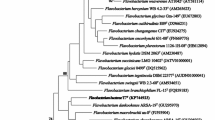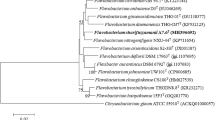Abstract
An aerobic, gram-negative, yellow-pigmented, and non-motile bacterium designated KMM 9535T was isolated from a marine sediment sample obtained from the Sea of Japan seashore and subjected to a phylogenetic and phenotypic study. On the basis of 16S rRNA gene sequence analysis, strain KMM 9535T was placed to the genus Flavobacterium sharing the highest sequence similarities to Flavobacterium ahnfeltiae KCTC 32467T (99.3 %), Flavobacterium jumunjinense KCTC 23618T (96.5 %), Flavobacterium ponti KCTC 22802T (96.3 %), Flavobacterium urocaniciphilum JCM 19142T (96.1 %), and Flavobacterium gelidilacus LMG 21477T (95.8 %). The DNA–DNA hybridization value between strain KMM 9535T and the closest related F. ahnfeltiae KCTC 32467T was 33 %. Strain KMM 9535T grew at 5–36 °C and in the presence of 0–3 % (w/v) NaCl. It contained MK-6 as the predominant menaquinone, and the major fatty acids were iso-C15:0, iso-C17:1, iso-C15:1, and iso-C17:0 3-OH. The DNA G+C content was 28.8 mol%. On the basis of the results obtained, it is proposed strain KMM 9535T to be classified as a novel species of the genus Flavobacterium, Flavobacterium maris sp. nov., with the type strain of the species KMM 9535T (=NRIC 0920T = KCTC 42093T).

Similar content being viewed by others
References
Bergey DH, Harrison FC, Breed RS, Hammer BW, Huntoon FM (1923) Genus II. Flavobacterium gen. nov. In: Bergey’s manual of determinative bacteriology. Williams & Wilkins, Baltimore, pp 97–117
Bernardet JF, Bowman JP (2011) Genus I. Flavobacterium Bergey et al. 1923. In: Whitman W (ed) Bergey’s manual of systematic bacteriology, vol 4, 2nd edn. Williams & Wilkins, Baltimore, pp 112–154
Bernardet JF, Segers P, Vancanneyt M, Berthe F, Kersters K, Vandamme P (1996) Cutting a gordian knot: emended classification and description of the genus Flavobacterium, emended description of the family Flavobacteriaceae, and proposal of Flavobacterium hydatis nom. nov. (basonym, Cytophaga aquatilis Strohl and Tait 1978). Int J Syst Bacteriol 46:128–148
Bernardet JF, Nakagawa Y, Holmes B (2002) Proposed minimal standards for describing new taxa of the family Flavobacteriaceae and emended description of the family. Int J Syst Evol Microbiol 52:1049–1070
Bowman JP (2000) Description of Cellulophaga algicola sp. nov., isolated from the surface of Antarctic algae, and reclassification of Cytophaga uliginosa (ZoBell and Upham 1944) Reichenbach 1989 as Cellulophaga uliginosa comb. nov. Int J Syst Evol Microbiol 50:1861–1868
Bruns A, Rohde M, Berthe-Corti L (2001) Muricauda ruestringensis gen. nov., sp. nov., a facultatively anaerobic, appendaged bacterium from German North sea intertidal sediment. Int J Syst Evol Microbiol 51:1997–2006
Collins MD, Shah HN (1984) Fatty acid, menaquinone and polar lipid composition of Rothia dentosacariosa. Arch Microbiol 137:247–249
Dong K, Chen F, Du Y, Wang G (2013) Flavobacterium enshiense sp. nov., isolated from soil, and emended descriptions of the genus Flavobacterium and Flavobacterium cauense, Flavobacterium saliperosum and Flavobacterium suncheonense. Int J Syst Evol Microbiol 63:886–892
Ezaki T, Hashimoto Y, Yabuuchi E (1989) Fluorometric deoxyribonucleic acid-deoxyribonucleic acid hybridization in micro-dilution wells as an alternative to membrane filter hybridization in which radioisotopes are used to determine genetic relatedness among bacterial strains. Int J Syst Bacteriol 39:224–229
Fautz E, Reichenbach H (1980) A simple test for flexirubin-type pigments. FEMS Microbiol Lett 8:87–91
Fujii D, Nagai F, Watanabe Y, Shirasawa Y (2014) Flavobacterium longum sp. nov. and Flavobacterium urocaniciphilum sp. nov., isolated from a wastewater treatment plant, and emended descriptions of Flavobacterium caeni and Flavobacterium terrigena. Int J Syst Evol Microbiol 64:1488–1494
Joung Y, Kim H, Joh K (2013) Flavobacterium jumunjinense sp. nov., isolated from a lagoon, and emended descriptions of Flavobacterium cheniae, Flavobacterium dongtanense and Flavobacterium gelidilacus. Int J Syst Evol Microbiol 63:3937–3943
Kang JY, Chun J, Jahng KY (2013) Flavobacterium aciduliphilum sp. nov., isolated from freshwater, and emended description of the genus Flavobacterium. Int J Syst Evol Microbiol 63:1633–1638
Kim OS, Cho YJ, Lee K, Yoon SH, Kim M, Na H, Park SC, Jeon YS, Lee JH, Yi H, Won S, Chun J (2012) Introducing EzTaxon-e: a prokaryotic 16S rRNA gene sequence database with phylotypes that represent uncultured species. Int J Syst Evol Microbiol 62:716–721
Marmur J, Doty P (1962) Determination of the base composition of deoxyribonucleic acid from its thermal denaturation temperature. J Mol Biol 5:109–118
Nedashkovskaya OI, Balabanova LA, Zhukova NV, Kim SJ, Bakunina IY, Rhee SK (2014) Flavobacterium ahnfeltiae sp. nov., a new marine polysaccharide-degrading bacterium isolated from a pacific red alga. Arch Microbiol 196:745–752
Owen J, Hill LR, Lapage SP (1969) Determination of DNA base composition from melting profiles in dilute buffers. Biopolymers 7:503–516
Pruesse E, Peplies J, Glöckner FO (2012) SINA: accurate high-throughput multiple sequence alignment of ribosomal RNA genes. Bioinformatics 28:1823–1829
Romanenko LA, Schumann P, Rohde M, Mikhailov VV, Stackebrandt E (2004) Reinekea marinisedimentorum gen. nov., sp. nov., a novel gammaproteobacterium from marine coastal sediments. Int J Syst Evol Microbiol 54:669–673
Romanenko LA, Uchino M, Frolova GM, Mikhailov VV (2007) Marixanthomonas ophiurae gen. nov., sp. nov., a novel marine bacterium of the family Flavobacteriaceae isolated from a deep-sea brittle star. Int J Syst Evol Microbiol 57:457–462
Romanenko LA, Tanaka N, Svetashev VI (2013) Devosia submarina sp. nov., isolated from deep sea surface sediments. Int J Syst Evol Microbiol 63:3079–3085
Sasser M (1990) Microbial identification by gas chromatographic analysis of fatty acid methyl esters (GC-FAME). Technical note 101. MIDI, Newark
Shida O, Takagi H, Kadowaki K, Nakamura LK, Komagata K (1997) Transfer of Bacillus alginolyticus, Bacillus chondroitinus, Bacillus curdlanolyticus, Bacillus glucanolyticus, Bacillus kobensis, and Bacillus thiaminolyticus to the genus Paenibacillus and emended description of the genus Paenibacillus. Int J Syst Bacteriol 47:289–298
Smibert RM, Krieg NR (1994) Phenotypic characterization. In: Gerhardt P, Murray RGE, Wood WA, Krieg NR (eds) Methods for general and molecular bacteriology. American Society for Microbiology, Washington, DC, pp 607–655
Stackebrandt E, Goebel BM (1994) Taxonomic note: a place for DNA–DNA reassociation and 16S rRNA sequence analysis in the present species definition in bacteriology. Int J Syst Bacteriol 44:846–849
Tamura K, Stecher G, Peterson D, Filipski A, Kumar S (2013) MEGA6: molecular evolutionary genetics analysis version 6.0. Mol Biol Evol 30:2725–2729
Van Trappen S, Mergaert J, Swings J (2003) Flavobacterium gelidilacus sp. nov., isolated from microbial mats in Antarctic lakes. Int J Syst Evol Microbiol 53:1241–1245
Yoon JH, Park S, Kang SJ, Oh SJ, Myung SC, Kim W (2011) Flavobacterium ponti sp. nov., isolated from seawater. Int J Syst Evol Microbiol 61:81–85
Acknowledgments
We would like to thank Dr. Claudine Vereecke, BCCM™/LMG Bacteria Collection, Ghent University, Belgium, and Dr. Jung-Sook Lee, the Korean Collection for Type Cultures (KCTC), Biological Resource Center (BRC), Korea Research Institute of Bioscience and Biotechnology (KRIBB), Daejeon, Korea, and Dr. Moriya Ohkuma, JCM, Japan Collection of Microorganisms, Japan, for providing Flavobacterium type strains for comparative analyses. This study was supported by a grant from the RSF “Biodiversity and biotechnological potential of marine bacteria and fungi” no. 14-14-00030.
Author information
Authors and Affiliations
Corresponding author
Additional information
Communicated by Erko Stackebrandt.
The DDBJ/GenBank/EMBL accession number of the 16S rRNA gene sequence of strain KMM 9535T is AB973429.
Rights and permissions
About this article
Cite this article
Romanenko, L.A., Tanaka, N., Svetashev, V.I. et al. Flavobacterium maris sp. nov. isolated from shallow sediments of the Sea of Japan. Arch Microbiol 197, 941–947 (2015). https://doi.org/10.1007/s00203-015-1128-x
Received:
Revised:
Accepted:
Published:
Issue Date:
DOI: https://doi.org/10.1007/s00203-015-1128-x




